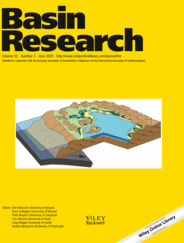
Full text loading...
 , Barbara Carrapa2, Peter G. DeCelles2, James Worthington3, Nicoletta Mancin4, Miriam Cobianchi4, Marius Stoica5, Xin Wang6, Mustafo Gadoev7, Ilhomjon Oimahmadov7
, Barbara Carrapa2, Peter G. DeCelles2, James Worthington3, Nicoletta Mancin4, Miriam Cobianchi4, Marius Stoica5, Xin Wang6, Mustafo Gadoev7, Ilhomjon Oimahmadov7
Investigation of a >6‐km‐thick succession of Cretaceous to Cenozoic sedimentary rocks in the Tajik Basin reveals that this depocentre consists of three stacked basin systems that are interpreted to reflect different mechanisms of subsidence associated with tectonics in the Pamir Mountains: a Lower to mid‐Cretaceous succession, an Upper Cretaceous–Lower Eocene succession and an Eocene–Neogene succession. The Lower to mid‐Cretaceous succession consists of fluvial deposits that were primarily derived from the Triassic Karakul–Mazar subduction–accretion complex in the northern Pamir. This succession is characterized by a convex‐up (accelerating) subsidence curve, thickens towards the Pamir and is interpreted as a retroarc foreland basin system associated with northward subduction of Tethyan oceanic lithosphere. The Upper Cretaceous to early Eocene succession consists of fine‐grained, marginal marine and sabkha deposits. The succession is characterized by a concave‐up subsidence curve. Regionally extensive limestone beds in the succession are consistent with late stage thermal relaxation and relative sea‐level rise following lithospheric extension, potentially in response to Tethyan slab rollback/foundering. The Upper Cretaceous–early Eocene succession is capped by a middle Eocene to early Oligocene (ca. 50–30 Ma) disconformity, which is interpreted to record the passage of a flexural forebulge. The disconformity is represented by a depositional hiatus, which is 10–30 Myr younger than estimates for the initiation of India–Asia collision and overlaps in age with the start of prograde metamorphism recorded in the Pamir gneiss domes. Overlying the disconformity, a >4‐km‐thick upper Eocene–Neogene succession displays a classic, coarsening upward unroofing sequence characterized by accelerating subsidence, which is interpreted as a retro‐foreland basin associated with crustal thickening of the Pamir during India–Asia collision. Thus, the Tajik Basin provides an example of a long‐lived composite basin in a retrowedge position that displays a sensitivity to plate margin processes. Subsidence, sediment accumulation and basin‐forming mechanisms are influenced by subduction dynamics, including periods of slab‐shallowing and retreat.

Article metrics loading...

Full text loading...
References


Data & Media loading...

